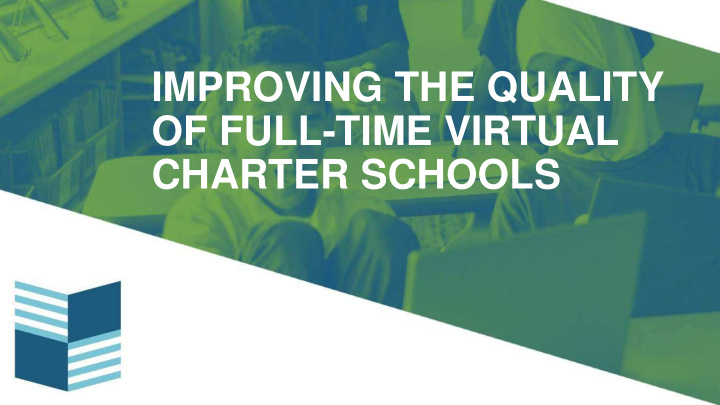



IMPROVING THE QUALITY OF FULL-TIME VIRTUAL CHARTER SCHOOLS
ABOUT THE NATIONAL ALLIANCE The leading non-profit organization focused on increasing student achievement by fostering a strong charter school sector. Our work focuses on four areas: Federal Policy, State Policy, Communications, Research and Data. 2
CHALLENGES WITH FULL-TIME VIRTUAL CHARTER SCHOOLS Very Low Academic Performance Enrollment (laws and scale) Wrong Financial Incentives 3
VERY LOW ACADEMIC PERFORMANCE In October 2015, three research organizations - the Center for Reinventing Public Education, Mathematica Policy Research and the Center for Research on Education Options (CREDO) - released three separate reports on the performance outcomes of students enrolled in full-time virtual charter schools. These studies revealed disturbingly low performance by most students enrolled in full-time virtual charter schools. 4
VERY LOW ACADEMIC PERFORMANCE (CREDO) 5
VERY LOW ACADEMIC PERFORMANCE (CREDO) 6
ENROLLMENT Because they are charter schools, full-time virtual charter schools must, by law, enroll every student who applies within established enrollment number parameters. 7
ENROLLMENT However, the nature of full-time virtual charter schools is such that they do not work for every student. 88% of virtual schools obtain significantly weaker growth in math and 67% in reading than their traditional public school peers. The average full-time virtual charter school student stays for a short time, and the mobility rates for students after they leave full-time virtual charter schools are extremely high. (CREDO) 8
ENROLLMENT Full-time virtual charter schools typically provide students with less live teacher contact time in a week than students in conventional schools have in a day. (Mathematica) 9
ENROLLMENT Most full-time virtual charter schools require high levels of student self- motivation as the instruction is mostly delivered asynchronously. Student success in a full-time virtual charter school depends on adult involvement in the home. Therefore, a full-time virtual charter school is a fit for only a small percentage of the student population. (CPRE) 10
ENROLLMENT Because of the ease of scaling, full-time virtual charter schools can grow very quickly, serving thousands of students overnight. If a large full-time virtual charter school fails, it can negatively impact thousands of kids. Since most state funding systems are based on enrollment and not the amount of time students actually stay at the full-time virtual charter school, taxpayers are often paying schools 100% of the per-pupil amount for students who were only enrolled for a short period of time. 11
WRONG FINANCIAL INCENTIVES: AUTHORIZERS As the main source of authorizer revenue is often based on a percentage of a school’s funding (which is based off enrollment numbers), there is an improper incentive for authorizers to keep large, poorly performing full-time virtual charter schools open. If they close the school, they lose significant revenues. 12
WRONG FINANCIAL INCENTIVES: OPERATORS One-quarter of full-time virtual charter schools account for almost 80 percent of enrollment. Almost 70 percent of full-time virtual charter schools are operated by for-profit entities. As funding is based on a per-pupil basis, the incentive is to drive up enrollment numbers . (K-12 spent just under $37 million per year on advertising*.) However, with high student churn rates, the mostly for-profit operators of full- time virtual charter schools receive millions in taxpayer dollars for students who will soon leave for another school. * K12 Inc. (2017, June 30). Form 14A 13
WRONG FINANCIAL INCENTIVES: OPERATORS “Both Connections, a subsidiary of Pearson, and K12 are growing year over year. K12’s 2017 revenues topped $889 million with $305 million of that considered overhead. According to Pearson’s Annual Report Connections FTE grew by 6 percent last year while revenues grew by 8 percent. Connections has 34 virtual schools in 28 states, and are opening 12 percent more schools annually. K12’s top five executives made a combined $11 million in FY17.” LESC/LFC Program Evaluation ● Virtual Charter Schools in New Mexico ● December 19, 2017 14
WRONG FINANCIAL INCENTIVES: OPERATORS “The majority of our revenues come from Managed Public School Programs and depend on per-pupil funding amounts and payment formulas remaining near the levels existing at the time we execute service agreements with the managed public schools we serve. If those funding levels or formulas are materially reduced or modified due to economic conditions or political opposition , new restrictions adopted or payments delayed, our business, financial condition, results of operations, and cash flows could be adversely affected.” (K12 Annual Report, 2016) 15
A CALL TO ACTION TO IMPROVE THE QUALITY OF FULL-TIME VIRTUAL CHARTER PUBLIC SCHOOLS Released in 2016, the report stresses support for full-time virtual charter schools but recommends policy options to improve outcomes. Recommendations are in the areas of authorizing, enrollment, accountability, and funding. 16
RECOMMENDATIONS: AUTHORIZING Only permit authorizers that have been granted statewide or regional chartering authority to oversee full-time virtual charter schools that enroll students from more than one district, while still allowing districts to authorize full-time virtual charter schools that enroll students only from within their districts. 17
RECOMMENDATIONS: ENROLLMENT States should require authorizers and schools to create desired enrollment levels for the full-time virtual charter schools for each year of a charter school’s contract. Only allow schools to grow – or not – based on academic performance . Require schools to selectively enroll their students. 18
RECOMMENDATIONS: FUNDING Fund full-time virtual charter schools based on actual costs, OR Fund full-time virtual charter schools based on a performance based model: UT, MN, NH, FL, (Pending: OH). 19
FOR ADDITIONAL INFORMATION Russ@Publiccharters.org 20
Recommend
More recommend